We are back from one full week of meetings, interesting sessions and many fruitful discussions at ASSW2023. Thanks to the organisers of the event for their excellent work, and to researchers, colleagues and project coordinators for meaningful exchanges and new ideas. Hereafter a short summary of some of INTERACT activities during the ASSW2023!
INTERACT TA User Community Meeting 2023
The 2nd TA User Community Meeting of INTERACT 3 took place on Monday 20th February, at 14:00-15:30, with online and in person participants. The meeting was organised in three parts: opening and welcome by WP3 lead Hannele Savela (Chair), highlight presentation by TA Users, Panel discussion. Recording of the highlight presentations will be available soon.
TA Users highlight presentations



After WP3 lead Hannele Savela opened the session with a short introduction of the INTERACT project, TA users presented their INTERACT granted research projects. TA users could provide interesting and diverse examples of the INTERACT TA/RA provision, as they came from different research fields (glaciologyThe study of glaciers. More, freshwaterrs, permafrostPermafrost is frozen ground that remains at or below zero degrees Celsius (32 degrees Fahrenheit) for two or more years. It forms in regions where the mean annual temperature is... More), had visited different INTERACT sites (Villum Research Station, Western Arctic Research Centre, CNR Arctic Station “Dirigibile Italia”, Toolik Field Station) in different countries (Greenland, Canada, Svalbard, USA) with more recent and older experiences, and were granted different types of access (TA, RA, combination of TA and RA). The highlight speakers were:
- Giovanni Baccolo, Paul Scherrer Institut, “Looking for radioactive contamination in the High Arctic”
- Ada Pastor, University of Girona, “Enhancing our Understanding of Nitrogen Dynamics in ArcticDefinitions of the Arctic vary according to environmental, geographical, political, cultural and scientific perspectives. Some scientists define the Arctic as areas having a high latitude, long winters, short, cool summers,... More Streams through Collaborative Sampling”
- Oriol Grau, University of Antwerpen, “Research experiences along a latitudinal transect within the INTERACT network”
Panel discussion
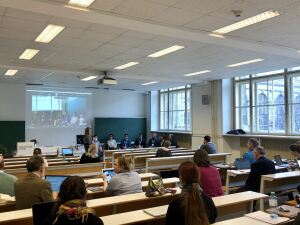
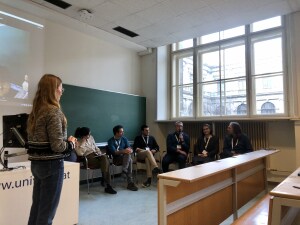
The panel discussion was an extremely useful for INTERACT coordinators to exchange views with station managers, TA users and other participants on the future directions of access provision, in particular with respect to Remote and Virtual Access opportunities. Panelists, who included TA users, station representatives and project coordinators, brought up the challenges and streghts of the different types of access and came up with interesting ideas on how to integrate research projects and foster collaboration among TA/RA user groups. Thanks to all who participated!
INTERACT booth: have a look to the INTERACT publications!
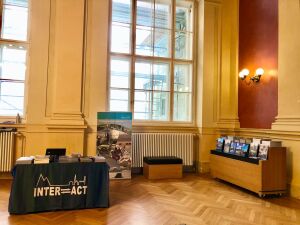
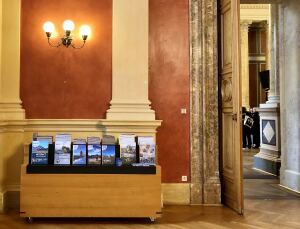 During the ASSW2023, INTERACT was present also with its own stand, offering copies of the different publications published by INTERACT in the last years: Stories of Arctic Science, Stories of Arctic Science II, Reducing CO2 Emission in Arctic Science, Reducing the Environmental Impact of Arctic Fieldwork, INTERACT Communications and Navigation Guidebook, INTERACT Fieldwork Planning Handbook, INTERACT Practical Field Guide, INTERACT Station Catalogue, Images of Arctic Science, and INTERACT Station Card Game. All INTERACT publications are freely available on the website here.
During the ASSW2023, INTERACT was present also with its own stand, offering copies of the different publications published by INTERACT in the last years: Stories of Arctic Science, Stories of Arctic Science II, Reducing CO2 Emission in Arctic Science, Reducing the Environmental Impact of Arctic Fieldwork, INTERACT Communications and Navigation Guidebook, INTERACT Fieldwork Planning Handbook, INTERACT Practical Field Guide, INTERACT Station Catalogue, Images of Arctic Science, and INTERACT Station Card Game. All INTERACT publications are freely available on the website here.
ArcticDefinitions of the Arctic vary according to environmental, geographical, political, cultural and scientific perspectives. Some scientists define the Arctic as areas having a high latitude, long winters, short, cool summers,... More terrestrial observing platforms: INTERACT GIS, INTERACT Data Portal and INTERACCESS

On February 22, Elmer Topp-Jørgensen, co-coordinator of the WP2 Station Managers Forum (SMF), and Hannele Savela, WP3 lead and TA Coordinator, presented some of the INTERACT platforms dedicated to ArcticDefinitions of the Arctic vary according to environmental, geographical, political, cultural and scientific perspectives. Some scientists define the Arctic as areas having a high latitude, long winters, short, cool summers,... More terrestial observations
INTERACT GIS: Updated and relaunched on Febraury 20, 2023, the platform allows researchers to get practical and useful information on research stations to detect the most appropriate station for their studies. It includes a tool to filter stations by different criteria (Discipline, Activity type supported, Keywords, and more) and helps visualise the location with a interactive map.
INTERACT Data Portal: It offers more than 1700 datasets from 14 research stations, allowing scientists to 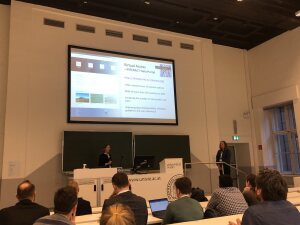 virtually access the stations and use already availble data for their research and studies. Data are open and freely available. The Virtual Access provision has many positive qualities: 1. Enhancing FAIR (Findability, Accessibility, Interoperability, and Reusability) data, 2. Reducing the environmental impact of ArcticDefinitions of the Arctic vary according to environmental, geographical, political, cultural and scientific perspectives. Some scientists define the Arctic as areas having a high latitude, long winters, short, cool summers,... More physical research, 3. Avoid the duplication of efforts and resources.
virtually access the stations and use already availble data for their research and studies. Data are open and freely available. The Virtual Access provision has many positive qualities: 1. Enhancing FAIR (Findability, Accessibility, Interoperability, and Reusability) data, 2. Reducing the environmental impact of ArcticDefinitions of the Arctic vary according to environmental, geographical, political, cultural and scientific perspectives. Some scientists define the Arctic as areas having a high latitude, long winters, short, cool summers,... More physical research, 3. Avoid the duplication of efforts and resources.
INTERACCESS: The INTERACT coordination tool functions as Application System, TA Board Project Evaluation platform, and Reporting System. It provides TA/RA Coordination with Quality Assurance report on key indicators, Reports on users, projects, user feedback, stations, Statistics and charts on user groups. It also includes Application manual, Reporting manual for Applicants, and List of available calls.
All the three platforms can be accessed from the homepage of the INTERACT website.
INTERACT within the EU Polar Cluster: Coordination and Communications
 INTERACT has then joined the two sessions of the EU Polar Cluster meetings concerning coordination and communications. INTERACT is indeed a member of the EU Polar Cluster project, which is a network of collaborative polar projects funded by the European Commission. Jointly we are aiming at providing policy-relevant information and supporting the EU in implementing its integrated policy for the ArcticDefinitions of the Arctic vary according to environmental, geographical, political, cultural and scientific perspectives. Some scientists define the Arctic as areas having a high latitude, long winters, short, cool summers,... More. The meetings focused on strategies to better connect and colaborate between the cluster members.
INTERACT has then joined the two sessions of the EU Polar Cluster meetings concerning coordination and communications. INTERACT is indeed a member of the EU Polar Cluster project, which is a network of collaborative polar projects funded by the European Commission. Jointly we are aiming at providing policy-relevant information and supporting the EU in implementing its integrated policy for the ArcticDefinitions of the Arctic vary according to environmental, geographical, political, cultural and scientific perspectives. Some scientists define the Arctic as areas having a high latitude, long winters, short, cool summers,... More. The meetings focused on strategies to better connect and colaborate between the cluster members.
